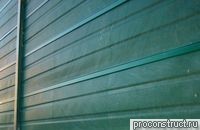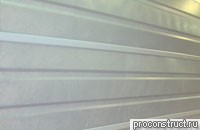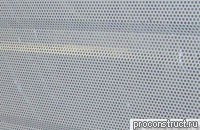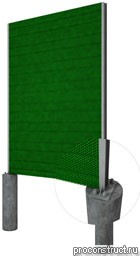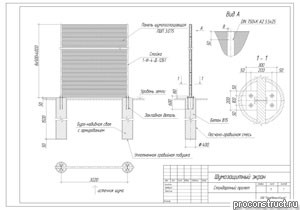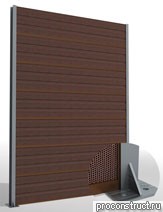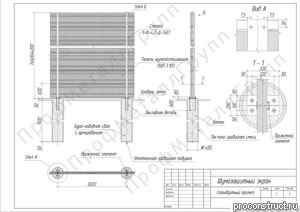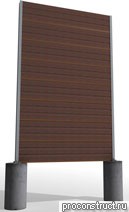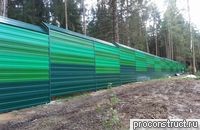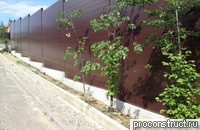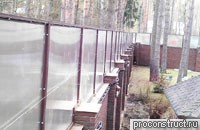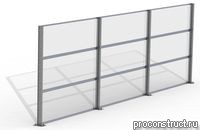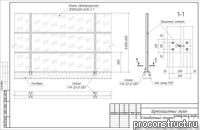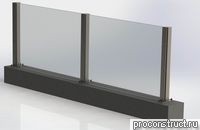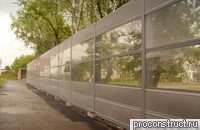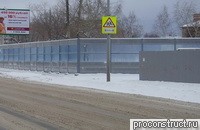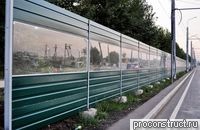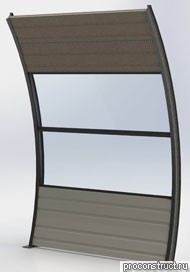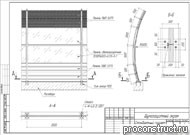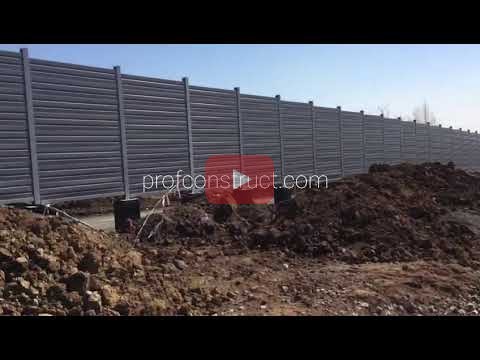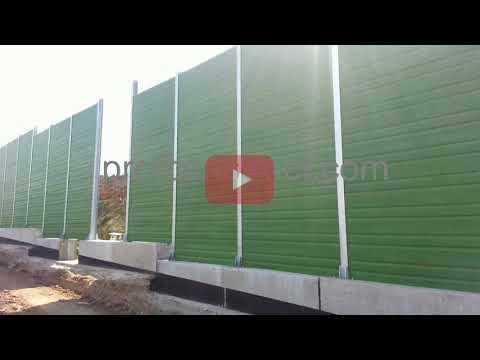Noise Barrier
ProfMetalGroup offers a full range of noise protection works: acoustic design, acoustic barrier design, base construction, acoustic panels and metal constructions making, noise barrier installation.
Upon the request of design organizations, we provide all necessary technical information about noise attenuating and noise reflecting panels, as well as about engineering features of metal frames for noise barriers produced by ProfMetalGroup.
Upon draft or design specification of construction companies, we define the necessary materials, provide assembly diagrams and installation manuals for ProfMetalGroup acoustic barriers.
Noise barriers are used to reduce airborne noise caused by traffic streams (railways, highways, airports). Also, they can be installed inside the premises of industrial buildings to reduce noise caused by production processes generating high noise levels, protect environment from noise near construction areas, ventilators and air conditioning units.
The main acoustic barrier feature is the degree of noise level reduction, measured in decibels. The measures are taken using a special device, the noise meter. Our noise barriers reduce the noise level by an average of 25-30 decibels. The maximum noise reduction level is up to 39 decibels.
Acoustic barriers with blind noise protective fireproof panels may be used as exterior panel frames and non-bearing self-supporting fire resistant walls, in case of fire serving as heat shields and balance insufficient width of fire separation distance between the buildings and structures.
Alongside with its main function, namely noise protection of residential areas, acoustic barriers become a part of the landscape, so they should be visually pleasing and seamlessly blending into the surrounding landscape.
By their function, noise barriers are divided into several groups:
Noise Attenuating Barrier
The main distinguishing feature of a noise attenuating barrier is about special perforated noise attenuating acoustic panels used in its production. When noise attenuating barriers are exposed to the sound wave, they absorb it through the openings on the front side, where the sound wave momentum energy is attenuated by a special acoustic material.
Noise attenuating barriers are mainly used in places requiring noise protection without harming the side opposite to the barrier. For example, erecting such barriers along highways or railways helps to avoid the return of the reflected sound wave back to cars or trains.
The same may be applied to the use of noise attenuating barriers for noise protection of sports facilities, stadiums, industrial premises, production sections where processes with high noise level take place, and for the protection of areas from the noise coming from construction sites.
We recommend you to use noise protective barriers not less than 3 m high because sound waves may not be completely attenuated if the barrier is lower.
Noise Reflecting Barrier
Unlike the noise attenuating barrier, the noise reflecting barrier does not attenuate a sound wave but reflects the major part of it, returning it back towards the noise source. Therefore, a noise source and the side opposite to the protected object are generally exposed to increased acoustic load. The difference of acoustic insulation factors of these barriers for a protected object is immaterial.
If a noise reflecting barrier is non-transparent, it will consist of blind metal noise reflecting panels, or, if transparent, it will be made of noise reflecting panels of solid PMMA glass or polycarbonate, or, if semi-transparent, of cellular polycarbonate. A noise barrier made of cellular polycarbonate has the lowest price among translucent noise barriers, but it is also the least efficient one. Cellular polycarbonate is rather light, allowing to install noise protective canopies on existing barriers.
Noise reflecting barriers made of blind metal panels are mainly applied to protect residential areas from noise coming from electric transformers, compressor units, pumping stations, industrial conditioning units, dry coolers, chillers, and industrial ventilators. Metal noise reflecting panel price is significantly lower than the price of perforated noise attenuating panels, so it is reasonable to use less expensive noise reflecting metal panels where it is possible to reduce the cost of noise barriers.
Noise reflecting barriers made of translucent panels are mainly installed along railways and highways if it is necessary to achieve acoustic load reduction and erect a visually light construction that will not obstruct the nearby landscape view or spoil the surrounding architectural look.
Combined Barrier
The main feature of combined noise barriers, in comparison with noise attenuating and noise reflecting ones, is the use of two or more different types of panels. The most frequent combination is perforated noise attenuating panels and transparent noise reflecting panels made of polycarbonate.
When noise barriers are built of noise attenuating panels along highways and railways, it is recommended to include transparent panels. They improve traffic safety in areas where visibility and even road illumination are impaired if the noise barrier wall is non-transparent. They also help to prevent obstruction of the view for drivers and residents and decrease both the feeling of confinement and the fatigue of drivers and passengers.
We recommend you to use blind metal acoustic insulating panels at the bottom because it offers the best protection from pollution and mechanical damage. Besides, the lower cost of metal noise protection panels allows to reduce the overall cost of the noise barrier. The application of combined barriers is similar to that of noise attenuating and noise reflecting barriers.
